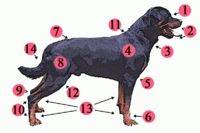
Photo from wikipedia
Ensuring the motion consistency of human and exoskeletons is the key to the research of wearable exoskeleton robots. However, as the complexity of the coupling of sliding and rolling motion… Click to show full abstract
Ensuring the motion consistency of human and exoskeletons is the key to the research of wearable exoskeleton robots. However, as the complexity of the coupling of sliding and rolling motion in human joint tissue, it is hard to depict the dynamic states of the joint axis. Exploring the changed human joint axis can be significant in the process of studying the bionic joint of the exoskeleton robots. We proposed a method to build the biological joint model based on anatomy and used screw theory to explore the human biological joint axis on it. The humerus and ulna models were only reconstructed by scanning CT images of the elbow joint in any single position. According to anatomy, humerus trochlear and trochlear notch of models were tangent to build a movable elbow joint model. The screw theory was used to study the elbow joint axis based on the kinematic data of samples in the motion simulation of joint model. Comparing the motion between model and human experiment, the ${\boldsymbol{R}^{\boldsymbol{2}}}$ of the Euler angles were above 0.97, and $\boldsymbol{RMSE}$ were below 2.85, which showed the model following anatomical principles can reflect the human joints well. And the pattern that depicted joint axis travelled is similar to the shape of the Mobius Strip. This work provides a new method to study human joint axis, and the axis results provide references to the design of exoskeleton joints and bionic robots.
Journal Title: IEEE Robotics and Automation Letters
Year Published: 2022
Link to full text (if available)
Share on Social Media: Sign Up to like & get
recommendations!